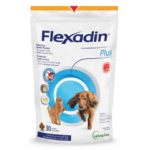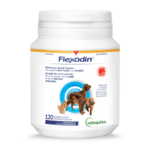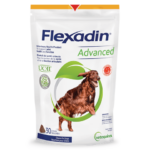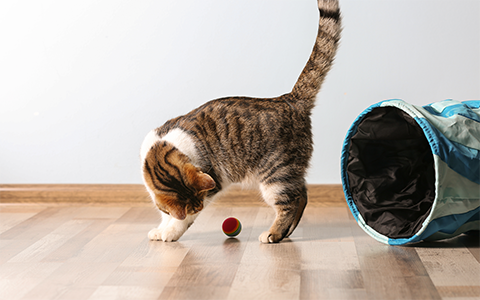Ostheoarthritis is a degenerative disease which causes inflammation of the joints, leading to chronic pain and decreased mobility. While typically considered to be a disease of old age, arthritis may be seen in dogs and cats at any stage of life. An early diagnosis provides an increased chance to course-correct the disease’s progression and improve your pet’s quality of life through treatment.
Talk to your veterinarian first
If you notice signs your dog or cat may be experiencing joint pain, contact your veterinary clinic for advice. They may ask you to monitor specific behaviour before bringing in your pet in for a physical examination. Your veterinarian will also consider existing health conditions or medication before recommending a treatment plan.
4 pillars of osteoarthritis treatment
Most pets respond well to a combination of four interdependent treatments:
1. Pain management for cats and dogs
Medication is the foundation of an osteoarthritis treatment plan. By helping manage pain, it increases mobility and makes it possible to exercise more. Common treatment options include anti-inflammatory drugs, narcotics, injectable medication, and in some cases, surgery.
Complementary approaches may also be used along with conventional medicine. For example, pet acupuncture is recognized by the American Animal Hospital Association as a compelling and safe method for pain management.
2. Increased exercise and mobility
Regular physical activity, such as daily walks for dogs and scheduled play time for cats, help improve the range of motion and build muscle strength to better support pressure on the joints. Animal physiotherapy can be used to achieve similar results. Increasing physical activity also contributes to maintaining a healthy body weight.
3. Reaching and maintaining a healthy weight
Weight management is another key part of most osteoarthritis treatment plans. Obesity causes additional stress on the joints, making the pain worse. Through physical activity and a healthy diet, weight loss helps relieve this pressure.
4. A balanced diet for your pet
Your veterinarian may recommend a specific brand of pet food formulated to help with weight control, or to adjust feeding quantity. They may also suggest including nutritional supplements designed to help support cartilage and slow down osteoarthritis progression.
Stronger muscles, a leaner body and healthy eating all contribute to diminishing the pain caused by osteoarthritis. This may in turn reduce the need for pain medication. Following this cycle, some pets’ condition gradually improves until they can achieve a satisfactory quality of life.
Innovative therapies for pet osteoarthritis
Pets suffering from existing conditions or taking other medications may not respond well to common pharmaceutical treatments. To address these, veterinary researchers are currently developing innovative therapies such as stem cell therapy, platelet-derived products, antibody-based agents, cannabinoids and radiosynovectomy, which involves the injection of small radioactive particles. While supporting evidence for many of these options is limited, their development could bring additional treatment options in the coming years.










